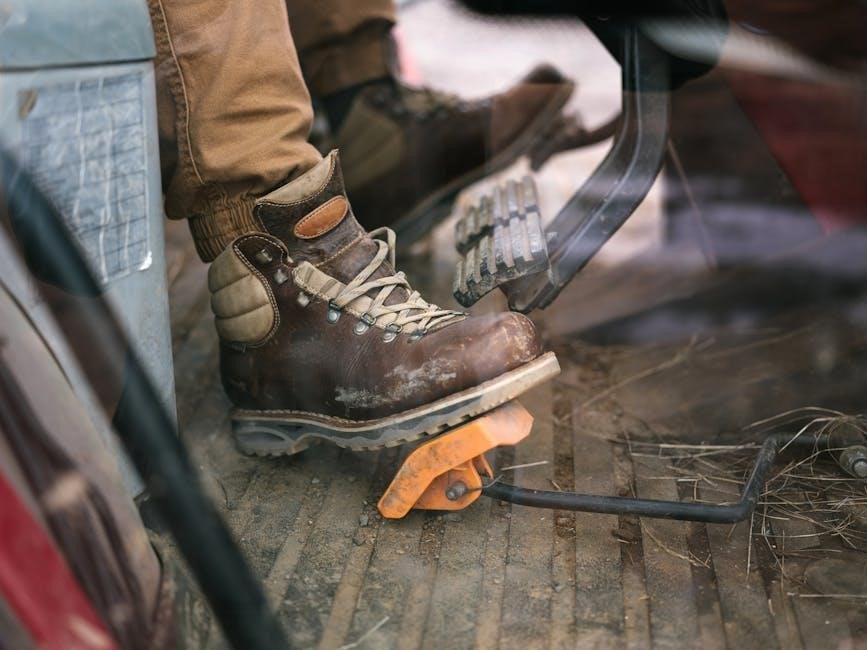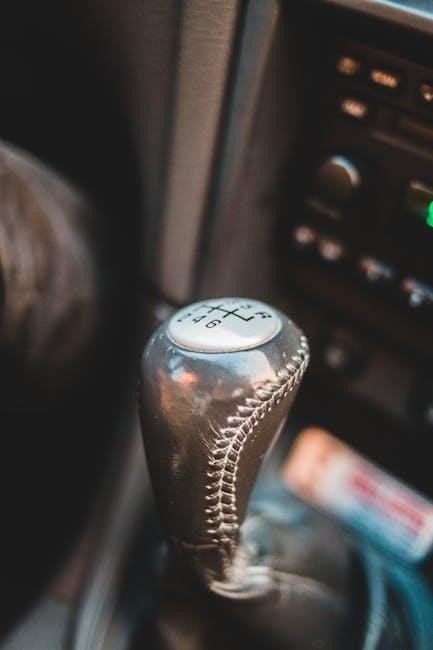A manual wheelchair is a vital mobility aid designed to enhance independence for individuals with physical disabilities. It offers cost-effective‚ durable‚ and easy-to-use solutions for daily navigation‚ promoting freedom and accessibility while requiring proper training to master driving techniques safely and effectively.
1.1 What is a Manual Wheelchair?
A manual wheelchair is a mobility aid designed for individuals with physical disabilities‚ enabling them to move independently. It is propelled by the user or an assistant using the push rims on the wheels. Typically‚ it consists of a sturdy frame‚ wheels‚ casters‚ seating‚ and footrests. Manual wheelchairs are lightweight‚ durable‚ and customizable to fit individual needs. They are widely used for their simplicity‚ cost-effectiveness‚ and ease of transportation. Proper training is essential to ensure safe and effective use‚ as it requires physical effort and coordination. Regular maintenance‚ such as checking tire pressure and lubricating moving parts‚ is also crucial for optimal performance and longevity.

1.2 Types of Manual Wheelchairs
Manual wheelchairs come in various designs to cater to different user needs and preferences. Standard wheelchairs are durable and suitable for everyday use‚ while lightweight models offer enhanced portability. Folding wheelchairs are ideal for easy storage and transport‚ making them a practical choice for travelers. Rigid frame wheelchairs provide superior stability and are often preferred by active users. Sports wheelchairs are designed for athletic activities‚ with a focus on maneuverability and performance; Pediatric wheelchairs are tailored for children‚ ensuring proper fit and growth accommodation. Bariatric wheelchairs are built for heavier users‚ emphasizing strength and comfort. Each type addresses specific requirements‚ ensuring users can select the most appropriate option for their lifestyle and mobility needs.
1.3 Importance of Learning to Drive a Manual Wheelchair
Learning to drive a manual wheelchair is essential for maximizing independence and mobility. It enhances confidence‚ allowing users to navigate various environments efficiently. Proper driving skills improve physical health by reducing strain and preventing long-term injuries. Additionally‚ it fosters self-reliance‚ enabling individuals to participate fully in daily activities and social interactions. Mastering wheelchair driving also promotes better navigation skills‚ ensuring safety in diverse settings. Overall‚ it significantly improves quality of life by empowering users to overcome accessibility challenges with ease and confidence.

Key Components of a Manual Wheelchair
Key components of a manual wheelchair include the frame‚ wheels‚ seating‚ footrests‚ and armrests. These elements ensure mobility‚ comfort‚ and durability‚ tailored to user needs.
2.1 Frame and Material
The frame of a manual wheelchair is its structural foundation‚ determining durability and performance. Common materials include aluminum‚ titanium‚ carbon fiber‚ and steel. Aluminum frames are lightweight and cost-effective‚ making them ideal for daily use. Titanium offers superior strength-to-weight ratio‚ enhancing durability while remaining lightweight. Carbon fiber frames are ultra-lightweight and corrosion-resistant‚ often used in high-end models for optimal energy efficiency. Steel frames are the strongest but heaviest‚ typically used for heavy-duty chairs. The choice of material significantly impacts the chair’s weight‚ portability‚ and maneuverability. A well-designed frame with appropriate material ensures comfort‚ stability‚ and longevity‚ catering to individual needs and preferences for effective mobility.
2.2 Wheels and Casters

Manual wheelchairs feature two main types of wheels: rear wheels and casters. Rear wheels are larger and designed for propulsion‚ typically made of durable materials like rubber or polyurethane. They are usually equipped with push rims‚ allowing users to drive the chair. Casters‚ located at the front‚ are smaller and swivel‚ enabling smooth turning and maneuverability. The size and material of both wheels impact performance‚ with larger rear wheels offering better propulsion on various terrains. Proper alignment and maintenance of wheels and casters are crucial for stability and ease of use‚ ensuring safe and efficient navigation of indoor and outdoor environments.
2.3 Seating and Cushioning
Proper seating and cushioning are essential for comfort and health when using a manual wheelchair; A well-designed seat ensures correct posture‚ reducing the risk of pressure sores and discomfort. Cushioning materials‚ such as gel or foam‚ provide support and pressure redistribution. Many wheelchairs offer adjustable seating options to accommodate different body types and needs. Additional features like breathable fabrics and lumbar support enhance overall comfort. Regular maintenance of cushions is crucial to maintain their effectiveness and hygiene. Proper fitting and adjustment of seating systems can significantly improve the user’s experience‚ ensuring long-term health and mobility. Always consult a professional to ensure the seating setup meets individual requirements.
2.4 Footrests and Armrests
Footrests and armrests are essential components of a manual wheelchair‚ providing comfort and support for the user. Footrests are typically adjustable‚ allowing users to position their feet comfortably‚ while armrests offer support for the arms‚ reducing strain during propulsion. Many wheelchairs feature flip-up or removable armrests for easier transfers. The materials used for these components‚ such as aluminum or carbon fiber‚ ensure durability while keeping the chair lightweight. Proper adjustment of footrests and armrests is crucial to maintain good posture and prevent fatigue. They also play a key role in balancing the chair‚ enhancing stability and maneuverability. Regular maintenance‚ like cleaning and lubricating hinges‚ ensures smooth operation of these parts.

Preparing to Drive a Manual Wheelchair

Assess physical ability‚ ensure proper fitting‚ and adjust the chair for comfort. Practice in a safe‚ open space and follow safety guidelines to build confidence and control.
3.1 Assessing Physical Ability
Assessing physical ability is crucial before driving a manual wheelchair. Evaluate strength‚ endurance‚ and mobility to ensure safe operation. Focus on upper body strength‚ as manual wheelchairs require arm and shoulder power for propulsion. Consider flexibility and coordination‚ as these impact maneuverability. A healthcare professional can help determine suitability and recommend adjustments. Proper assessment ensures the user can handle the chair’s weight and navigate various terrains effectively. This step is essential for maximizing independence and minimizing risks associated with improper use. Starting with flat surfaces and gradually progressing to more challenging environments can help build confidence and skill. Always prioritize physical comfort and safety during the assessment process.
3.2 Proper Fitting and Adjustment
Proper fitting and adjustment of a manual wheelchair are essential for optimal comfort‚ efficiency‚ and safety. A professional assessment ensures the chair matches the user’s body dimensions and mobility needs. The seat width‚ depth‚ and height should align with the user’s measurements to prevent discomfort or restricted movement. The backrest height and angle should provide adequate support without limiting upper body mobility. Armrests and footrests must be adjusted to maintain proper posture and reduce strain on the shoulders and legs. Regular adjustments are necessary as the user’s condition or preferences evolve. Proper fitting not only enhances performance but also prevents long-term health issues‚ such as pressure sores or poor posture‚ ensuring a better overall experience.
3.3 Safety Precautions
When driving a manual wheelchair‚ safety is paramount to prevent accidents and injuries. Always inspect the chair for damage or wear before use. Wear a properly fitted seatbelt to avoid slipping. Navigate slopes and uneven surfaces cautiously‚ ensuring stability. Avoid overreaching‚ as this can tip the chair. Use brakes on inclines and never lean backward. Be mindful of obstacles like cracks or debris. In traffic‚ stay visible with reflective gear and follow pedestrian rules. Avoid driving in poor lighting or weather conditions. Regularly check tire pressure and functionality of brakes and wheels. Stay alert and maintain control‚ especially in crowded areas. Prioritize awareness and caution to ensure safe mobility.

Basic Driving Techniques
Mastering basic techniques like starting‚ stopping‚ turning‚ and braking ensures safe and efficient navigation. Proper hand positioning and body alignment are crucial for effective control and maneuverability.
4.1 Starting and Stopping
Mastering the basics of starting and stopping is essential for safely operating a manual wheelchair. To start‚ ensure proper posture and a firm grip on the wheel rims. Push the rims forward with your hands‚ using your shoulders and arms for power. On level surfaces‚ a gentle‚ consistent motion is sufficient; When starting on an incline‚ apply more force to gain momentum. To stop‚ gradually slow your pushing rhythm and use the natural resistance of the wheels. For a complete halt‚ apply slight pressure to the rims while they are rolling backward. Always maintain control and balance during these maneuvers. Practice in a safe‚ open area to build confidence and precision in starting and stopping smoothly.

4.2 Turning and Maneuvering
Mastering turning and maneuvering is essential for effective manual wheelchair navigation. To execute a turn‚ shift your body weight in the desired direction while angling the wheels accordingly. For tighter spaces‚ use a “pivotal” turn by rotating the wheels in opposite directions. When maneuvering in confined areas‚ precise control over speed and alignment is crucial. Practice turning at different angles and speeds to build confidence and accuracy. Always maintain balance by keeping your center of gravity over the wheelchair’s base. Proper hand placement on the wheels ensures better control during sharp turns. Regular practice in various environments will enhance your ability to navigate smoothly and efficiently‚ even in challenging spaces.
4.3 Braking and Control
Mastering braking and control is essential for safe and efficient manual wheelchair navigation. Most wheelchairs feature push-to-lock or lever-operated brakes that secure the rear wheels‚ preventing movement. Proper braking techniques ensure stability‚ especially on inclines or uneven surfaces. Users should apply brakes gradually and evenly to avoid skidding or loss of control. Additionally‚ maintaining firm grip on the wheels enhances maneuverability‚ while subtle shifts in body weight can aid in steering. Regular inspection of brake mechanisms is crucial to ensure optimal performance and safety. By combining these strategies‚ users can achieve precise control over their wheelchair‚ navigating various environments with confidence and ease.
Advanced Driving Techniques
Mastering advanced techniques enhances mobility and confidence. Skills include navigating stairs‚ curbs‚ and uneven terrains‚ as well as efficiently using public transportation‚ ensuring smooth and safe travel in various environments.
5.1 Navigating Stairs and Curbs
Navigating stairs and curbs in a manual wheelchair requires skill and caution to ensure safety; Always assess the environment beforehand to identify the safest routes. For curbs‚ position the wheelchair at an angle‚ ensuring the wheels can roll over smoothly. Use the strength in your arms to propel forward‚ maintaining balance. For stairs‚ it’s crucial to have assistance unless you are highly experienced. When descending‚ always go backward‚ using the railing for support. Never attempt stairs without proper training or assistance‚ as this can lead to accidents. Practice these techniques in a controlled environment to build confidence and proficiency. Safety should always be the top priority when navigating uneven or elevated surfaces.
5.2 Driving on Different Terrains
Mastering the ability to drive a manual wheelchair on various terrains is essential for seamless mobility. Paved surfaces‚ such as sidewalks and ramps‚ allow for smooth navigation‚ while uneven terrain like grass or gravel may require slower speeds and additional effort. Inclines and declines demand careful control to maintain balance and safety. Soft surfaces‚ like sand or snow‚ can be challenging due to reduced traction‚ necessitating adaptive techniques or specialized wheels. Always assess the path ahead‚ use gloves for better grip on rough surfaces‚ and slow down when approaching obstacles. Practicing on different terrains builds confidence and ensures safe‚ efficient movement in diverse environments.
5.3 Using Public Transportation
Using public transportation with a manual wheelchair requires planning and awareness. Many buses and trains are equipped with ramps or lifts for easy access. Always prioritize routes with accessible vehicles and stations. When boarding‚ position your wheelchair securely‚ using available restraints if provided. Be mindful of priority seating areas and ensure clear communication with drivers or staff. Familiarize yourself with schedules and routes in advance to avoid delays. Additionally‚ consider using accessible apps or websites for real-time updates and navigation assistance. Etiquette‚ such as yielding space to others when needed‚ helps ensure a smooth experience for all passengers. Practice these strategies to enhance your confidence and independence while traveling;

Maintenance and Care
Regular maintenance ensures optimal performance and longevity. Clean wheels and frames‚ lubricate moving parts‚ check tire pressure‚ inspect for wear‚ tighten bolts‚ replace worn components.
6.1 Regular Maintenance Checks
Regular maintenance checks are essential to ensure the longevity and functionality of a manual wheelchair. Start by inspecting the tires for proper inflation and wear‚ as underinflated or damaged tires can affect mobility and control. Check the brakes for responsiveness and adjust or replace them if necessary. Examine the frame for any signs of damage or rust‚ and tighten loose bolts or screws. Lubricate moving parts‚ such as wheel axles and joints‚ to prevent friction and corrosion. Additionally‚ test the folding mechanism to ensure smooth operation. Schedule professional inspections annually to address any hidden issues. Regular checks not only prevent breakdowns but also ensure safety and optimal performance.

6.2 Cleaning and Lubrication
Regular cleaning and lubrication are essential for maintaining the performance and longevity of a manual wheelchair. Use a mild detergent and soft cloth to wipe down the frame‚ wheels‚ and other components‚ avoiding harsh chemicals that may damage finishes. Lubricate moving parts‚ such as wheel axles and caster bearings‚ with silicone-based sprays to ensure smooth operation. Avoid over-lubrication‚ as it can attract dust and dirt. Clean wheels and casters frequently to remove debris that may hinder movement. Proper maintenance not only enhances mobility but also prevents wear and tear‚ ensuring the wheelchair remains reliable for years. Always follow the manufacturer’s guidelines for specific care instructions.
6.3 Troubleshooting Common Issues
Regular maintenance and quick troubleshooting are essential for optimal manual wheelchair performance. Common issues include flat tires‚ loose brakes‚ or worn caster wheels. Always check tire pressure and tighten bolts regularly. If the chair feels unbalanced‚ adjust the axle or consult a professional. For squeaky parts‚ apply lubricant to moving components. If the frame is damaged‚ replace it immediately to ensure safety. Addressing these issues promptly prevents further damage and ensures smooth operation. Keep a toolkit handy for minor adjustments and refer to the manufacturer’s guide for specific solutions. Proper care extends the wheelchair’s lifespan and maintains user comfort and mobility.
Resources and Support
Online communities‚ professional training‚ and manufacturer guidelines provide essential support for mastering manual wheelchair driving‚ ensuring safety‚ and maintaining independence through shared knowledge and expert guidance.
7.1 Online Communities and Forums
Online communities and forums provide invaluable support for individuals learning to drive a manual wheelchair. These platforms connect users with experienced wheelchair drivers‚ offering tips‚ troubleshooting advice‚ and shared experiences. Many forums focus on mobility and accessibility‚ allowing users to ask questions and receive personalized guidance. They also serve as hubs for discussing the latest advancements in wheelchair technology and maintenance. Additionally‚ these communities often share resources for local support groups and workshops. Engaging with online forums can enhance one’s confidence and skills in navigating various environments. They foster a sense of belonging and provide emotional support‚ which is crucial for individuals adapting to wheelchair use. Active participation in these communities can significantly improve one’s overall mobility and independence.
7.2 Professional Training and Workshops
Professional training and workshops are essential for mastering the skills needed to drive a manual wheelchair effectively. These programs‚ often conducted by certified therapists or experienced instructors‚ provide personalized guidance to ensure safe and efficient mobility. Workshops typically cover topics such as proper posture‚ maneuvering techniques‚ and navigating various terrains. Participants also learn how to handle emergencies and maintain their wheelchairs. Many organizations offer structured courses tailored to different skill levels‚ from beginners to advanced users. These sessions foster confidence and independence‚ enabling individuals to fully utilize their wheelchairs in daily life. Additionally‚ workshops may include hands-on exercises and interactive demonstrations‚ making learning engaging and practical.
7.3 Manufacturer Guidelines and Manuals
Manufacturer guidelines and manuals are essential resources for understanding and maintaining your manual wheelchair. These documents provide detailed instructions on assembly‚ usage‚ and maintenance‚ ensuring safety and longevity. They often include troubleshooting tips and warranty information‚ helping users address common issues. By following these guidelines‚ users can optimize their wheelchair’s performance and ensure compliance with safety standards. Manuals may also offer insights into customization options and accessory installations. Always refer to the manufacturer’s official materials for accurate and reliable information tailored to your specific model. Adhering to these guidelines helps preserve the warranty and ensures the wheelchair remains in optimal condition for years of reliable use.
